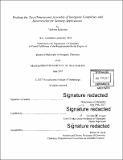| dc.contributor.advisor | Timothy M. Swager. | en_US |
| dc.contributor.author | Krikorian, Markrete | en_US |
| dc.contributor.other | Massachusetts Institute of Technology. Department of Chemistry. | en_US |
| dc.date.accessioned | 2017-12-05T19:16:24Z | |
| dc.date.available | 2017-12-05T19:16:24Z | |
| dc.date.copyright | 2017 | en_US |
| dc.date.issued | 2017 | en_US |
| dc.identifier.uri | http://hdl.handle.net/1721.1/112517 | |
| dc.description | Thesis: Ph. D. in Inorganic Chemistry, Massachusetts Institute of Technology, Department of Chemistry, 2017. | en_US |
| dc.description | Cataloged from PDF version of thesis. | en_US |
| dc.description | Includes bibliographical references. | en_US |
| dc.description.abstract | Chemiresistive sensing is a facile, affordable, efficient, and translatable way to detect compounds at concentrations as low as parts per billion; however, the key mechanism of molecular sensing is still unknown. In this thesis, a fundamental approach is used to study molecular assembly and reactivity by looking at the intermolecular interactions of each system presented to determine how specific interactions impact the macroscopic properties or ability of the chemical species to detect incoming analyte gases relevant for chemical sensing. Scanning Tunneling Microscopy (STM) was used as a primary tool to better understand the changes to a sensing system at the molecular level. In a similar vein, several platinum complexes useful as luminescence-based chemical sensors were studied using various liquid crystalline characterization techniques to understand how their intermolecular properties impacted their bulk assembly behavior. The Swager lab has developed chemiresistive and luminescence-based sensors for a wide variety of applications and it is the hope that fundamental studies such as this will help elucidate the molecular basis of the sensing response and in the long term will allow for the development of more sophisticated and predictable sensors. | en_US |
| dc.description.statementofresponsibility | by Markrete Krikorian. | en_US |
| dc.format.extent | 126 pages | en_US |
| dc.language.iso | eng | en_US |
| dc.publisher | Massachusetts Institute of Technology | en_US |
| dc.rights | MIT theses are protected by copyright. They may be viewed, downloaded, or printed from this source but further reproduction or distribution in any format is prohibited without written permission. | en_US |
| dc.rights.uri | http://dspace.mit.edu/handle/1721.1/7582 | en_US |
| dc.subject | Chemistry. | en_US |
| dc.title | Probing the two-dimensional assembly of inorganic complexes and heterocycles for sensing applications | en_US |
| dc.type | Thesis | en_US |
| dc.description.degree | Ph. D. in Inorganic Chemistry | en_US |
| dc.contributor.department | Massachusetts Institute of Technology. Department of Chemistry | |
| dc.identifier.oclc | 1012610969 | en_US |
